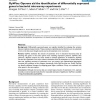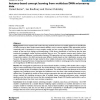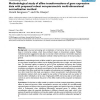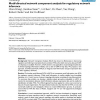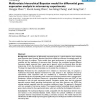BMCBI
2006
14 years 7 months ago
2006
Background: Multicategory Support Vector Machines (MC-SVM) are powerful classification systems with excellent performance in a variety of data classification problems. Since the p...
BMCBI
2006
14 years 7 months ago
2006
Background: Non-negative matrix factorisation (NMF), a machine learning algorithm, has been applied to the analysis of microarray data. A key feature of NMF is the ability to iden...
BMCBI
2006
14 years 7 months ago
2006
Background: Differentially expressed genes are typically identified by analyzing the variation between replicate measurements. These procedures implicitly assume that there are no...
BMCBI
2006
14 years 7 months ago
2006
Background: The incorporation of statistical models that account for experimental variability provides a necessary framework for the interpretation of microarray data. A robust ex...
106
click to vote
BMCBI
2006
14 years 7 months ago
2006
Background: Selection of relevant genes for sample classification is a common task in most gene expression studies, where researchers try to identify the smallest possible set of ...
BMCBI
2006
14 years 7 months ago
2006
Background: Various statistical and machine learning methods have been successfully applied to the classification of DNA microarray data. Simple instance-based classifiers such as...
BMCBI
2006
14 years 7 months ago
2006
Background: Gene expression microarray data is notoriously subject to high signal variability. Moreover, unavoidable variation in the concentration of transcripts applied to micro...
BMCBI
2006
14 years 7 months ago
2006
Background: Low-level processing and normalization of microarray data are most important steps in microarray analysis, which have profound impact on downstream analysis. Multiple ...
BMCBI
2008
14 years 7 months ago
2008
Background: Network Component Analysis (NCA) has shown its effectiveness in discovering regulators and inferring transcription factor activities (TFAs) when both microarray data a...
BMCBI
2008
14 years 7 months ago
2008
Background: Identification of differentially expressed genes is a typical objective when analyzing gene expression data. Recently, Bayesian hierarchical models have become increas...

